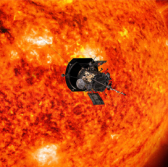 NASA has announced it will launch the car-sized Parker Solar Probe on Aug. 6 for a mission to study the sun at a close distance.
NASA has announced it will launch the car-sized Parker Solar Probe on Aug. 6 for a mission to study the sun at a close distance.
The spacecraft will launch aboard a United Launch Alliance Delta IV Heavy rocket, as part of a project headed by Nicky Fox, a scientist from Johns Hopkins University Applied Physics Lab, NASA said Saturday.
Fox, along with Alex Young, associate director for science in the Heliophysics Science Division at NASA’s Goddard Space Flight Center, presented the project’s goals at a press conference.
The project aims to answer foundational questions about the sun, identify the reasons for the corona’s extra-high temperatures and attempt to identify the mechanisms that work to accelerate solar energetic particles.
The solar probe will carry four instrument suites designed to help achieve the project’s goals via remote and direct study methods.
First, the University of California at Berkeley’s FIELDS suite is designed to measure electric and magnetic fields that surround a spacecraft for study of the fields related to waves, shocks and magnetic reconnection.
Second, the Naval Research Laboratory’s Wide-Field Imager for Parker Solar Probe or WISPR works to capture images of sun-ejected structures.
Third, the Solar Wind Electrons Alphas and Protons Investigation – SWEAP – measures electrons, protons and helium ions, as well as physical properties, within solar wind. The University of Michigan, the University of California, Berkeley and the Smithsonian Astrophysical Observatory led the development of SWEAP.
Lastly, the Integrated Science Investigation of the Sun, or ISʘIS, suite functions to study the life cycle and origins of particles.
The Parker Solar Probe supports the space agency’s Living with a Star Program, which seeks to study the characteristics of the Sun-Earth system that affect human life.




